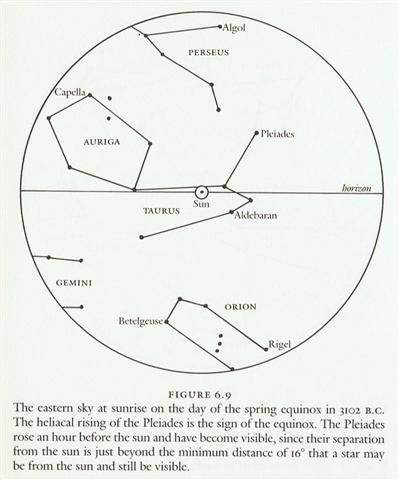|
5. Antares is said to be the 'entrance pillar' and Aldebaran the 'rear pillar'. North of the equator it should be the opposite, with Taurus at the beginning of summer and Scorpius at its end. By adding 'at the foot of which was the place for tattoing' it seems to be made clear that the 'rear pillar' stands at the rear end of the season of light (summer). Tattooing creates dark patterns and we remember the myth about Mataora ('Living Face') who was searching for his wife in the Underworld, cfr at Moko, where he was taught the art of true tattooing. My initial idea that side a of the G tablet describes the front side of the year must be reconsidered. Aldebaran is evidently depicted as a rising vaha mea fish early on side a and its heliacal rise should on Easter Island indicate the end of the season of light. But the beginning of side a can anyhow be read as referring to spring on Easter Island - given that we are watching the stars in the night in order to find the position of Sun by the nakshatra method as described by Worthen (cfr at Camp 5): ... In Hindu legend there was a mother goddess called Aditi, who had seven offspring. She is called 'Mother of the Gods'. Aditi, whose name means 'free, unbounded, infinity' was assigned in the ancient lists of constellations as the regent of the asterism Punarvasu. Punarvasu is dual in form and means 'The Doublegood Pair'. The singular form of this noun is used to refer to the star Pollux. It is not difficult to surmise that the other member of the Doublegood Pair was Castor. Then the constellation Punarvasu is quite equivalent to our Gemini, the Twins. In far antiquity (5800 B.C.) the spring equinoctial point was predicted by the heliacal rising of the Twins ... By 4700 B.C. the equinox lay squarely in Gemini ... An example of the operation of the Nakshatra system in antiquity can be seen in figure 6.9.
Here we see that the spring equinox occurred when the sun was at its closest approach to the star Aldebaran (called Rohini by the Hindus) in our constellation Taurus. But, of course, the phenomenon would not have been visible because the star is too close to the sun for observation. The astronomers would have known, however, that the equinoctial point was at Aldebaran by observing the full moon falling near the expected date or near a point in the sky exactly opposite Aldebaran (since the full moon is 180º from the sun), that is, near the star Antares ... An observer south of the equator can observe Aldebaran in the night in order to know when Antares is rising heliacally. But today Antares will no longer be at spring equinox (south of the equator) because precession has seemingly 'pushed the stars ahead' in the year. Nowadays the heliacal rising of Antares comes at right ascension 16h 26m or (16 * 60 + 26) / 1440 * 365¼ = 250 days after spring equinox north of the equator. It means the heliacal rising of Antares will be 250 - 186 = 64 days after spring equinox if observed from Easter Island:
186 can be counted as the difference between the day numbers for autumn equinox and spring equinox north of the equator. Or it can be counted as 266 + 87 - 365 south of the equator. Mago in Ga7-16 is glyph number 186 and by adding 64 (the number of glyphs from Rogo in Gb6-26 to the end of side b) we will find it is at day number 250 after spring equinox north of the equator (= day number 250 after autumn equinox south of the equator). Therefore the heliacal rise of Antares will on Easter Island be a sign of high summer ahead. By the nakshatra method Aldebaran can instead be watched in the night and used to find the same time of the year. Spring equinox on Easter Island should therefore be at a position which is 64 glyphs earlier than mago in Ga7-16:
Glyph number 122 is a viri, a type of glyph which probably implies 'cardinal point'. The preceding Rogo carries a sign in front which is similar to that in Ga1-21 at Phakt (Phaet), though reversed. These glyphs support my interpretation of viri in Ga5-11 as a sign of spring equinox (186 days after autumn equinox). North of the equator the distance from autumn equinox to spring equinox is only 180 days. |
||||||||||||||||||||||||||||||||||


